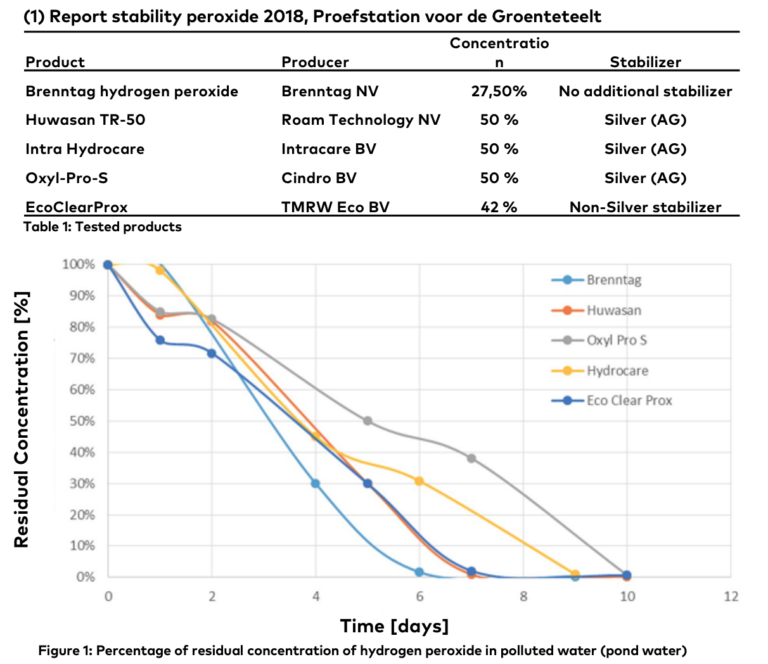
EcoClearProx® (ECP)
noun [ U ] . CHEMISTRY.
meaning: Versatility
EcoClearProx is an eco-friendly alternative solution for disinfection, decontamination, and pathogen control in various industries.
High stability meets sustainability
ECP formulation does not include commonly used additives like silver nitrate, inorganic salts or various phosphonic acids. The result is 100% biodegradable organic hydrogen peroxide with very high stability as proven by various test results.
In comparison to other H2O2 products, ECP has a profound shelf life which is important for transport.
Better Results – Less Harm
An increasing number of studies are raising concerns about health and environmental risks associated with nano-silver. As a consequence, regulatory rules have been made stricter and will continue to be tightened. Recent studies have shown that silver affects soil properties, microorganisms, and plants — therefore increasing toxicity for living organisms, including humans.
- Significant decrease in fresh weights, root elongation, shoot and root development
- Reduction in fruits’ productivity
- Significant decrease in root growth
- Delay in flowering, decrease in petal development
- Vegetative growth, and pollen viability
Studies have also shown that exposure to Silver Nanoparticles resulted in accumulation of silver in tomato plants and affected the vascular tissue structure with impact on the balance of water and nutrient dynamics, and plant growth.
EcoClearProx® is a stabilized hydrogen peroxide solution without addition of silver and has no negative implications for sustainable agriculture and ultimately human health.
Hydrogen Peroxide eliminates contaminants in polluted water through reaction with the organic matter. In independent comparison with silver-stabilized products(1), EcoClearProx has shown the most rapid reaction in polluted water, as indicated by the strongest decrease of concentration.
Thus, in operational use cases (e.g. drinking water disinfection, elimination of biofilm) EcoClearProx achieves fastest elimination of pathogens in piping systems and ensures only decontaminated water leaves the system.

Demonstrated efficacy in all disinfection applications
EcoClearProx® provides a valuable alternative solution to chlorination.
Due to disinfection by-product, many communities have become hesitant in the continuation of chlorine based desinfection. In Europe chlorination has been discontinued in many communities.
Efficacy tests of EcoClearProx® against the same amount of chlorine found that 83.6 liters of ECP 42,1% corresponds with 1000 liters of Chlorine 33%.
Chlorine’s disinfection efficacy is relative to the pH of the water. As pH increases, chlorine becomes less effective. As pH decreases, chlorine becomes more effective but water might become corrosive to pipes.
The efficacy of EcoClearProx® is not influenced by the pH of the water.
Undesired compounds may be produced from chlorine’s reaction to organic matter. The compounds of most concern right now are trihalomethanes (THMs) and haloacetic acids (HAAs). Since there may be potential health effects of both, the U.S. Environmental Protection Agency (EPA) adopted the Stage 1 Disinfectants and Disinfection Byproducts Rule (DBPR), which specifies maximum allowable levels and monitoring requirements for disinfectants and DBPs.
Because the health risks by bacteria and other disease-causing microorganisms outweigh the health risks of DBPs, chlorination is still used.
EcoClearProx does not result in any harmful byproducts and eliminates the risk tradeoff.
Biolfilm in drinking water can enable water contamination. Studies have indicated that, despite chlorination, significant numbers of bacteria can survive in the biofilm present in drinking water. Achieving sufficient disinfection is essential since untreated biofilm could lead to populations of resistant bacteria.
EcoClearProx eliminates biofilm.
The chlorination of drinking water results in an unpleasant taste and odor. EcoClearProx disinfection has no flavor or odor.
